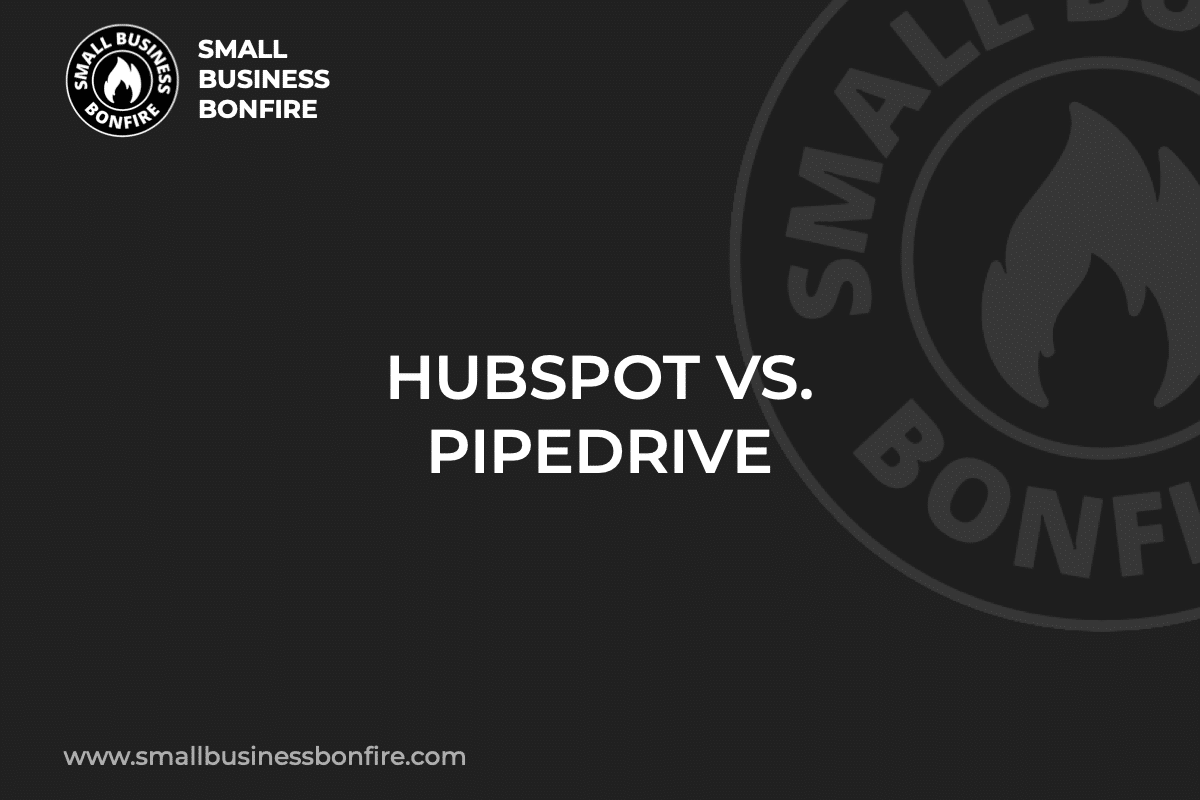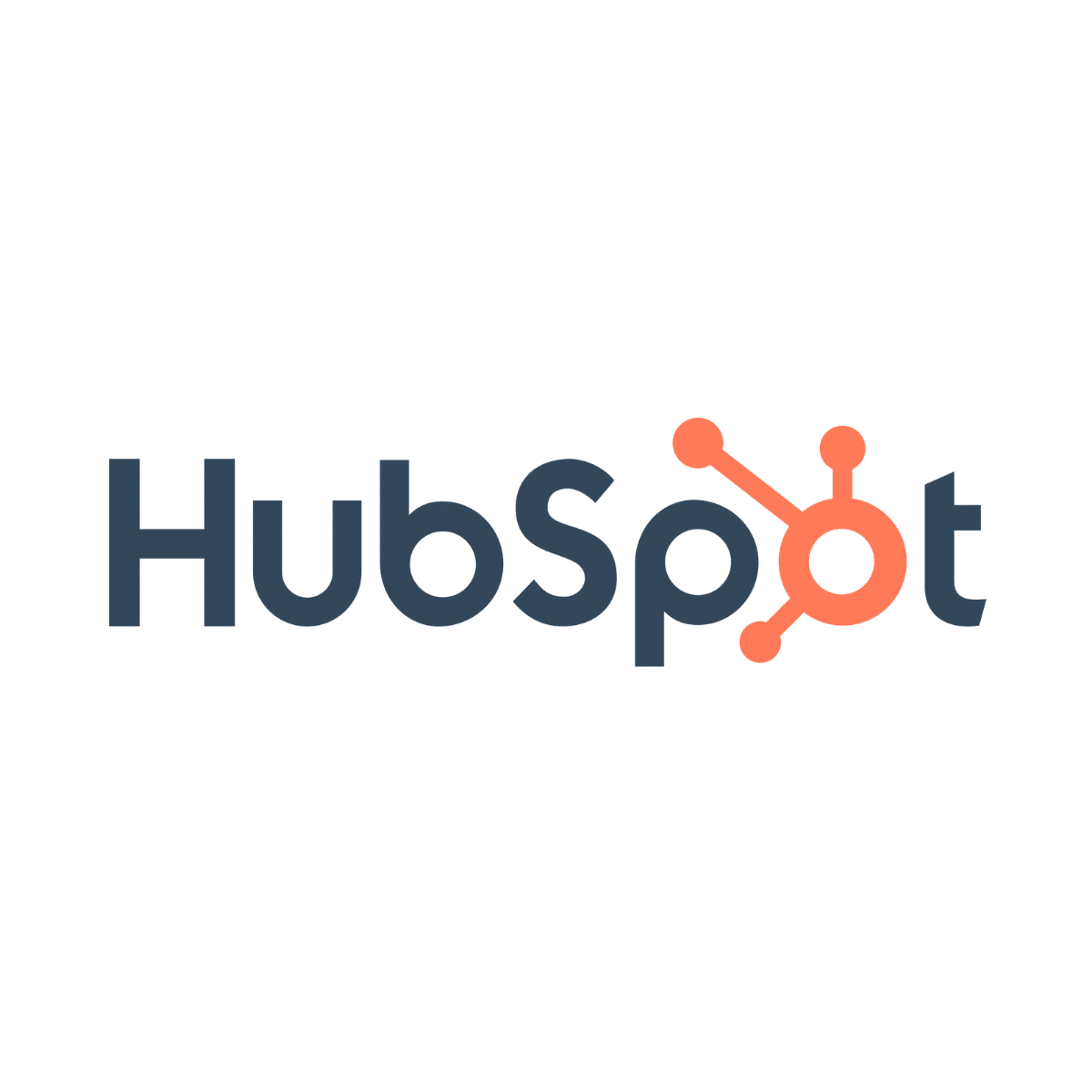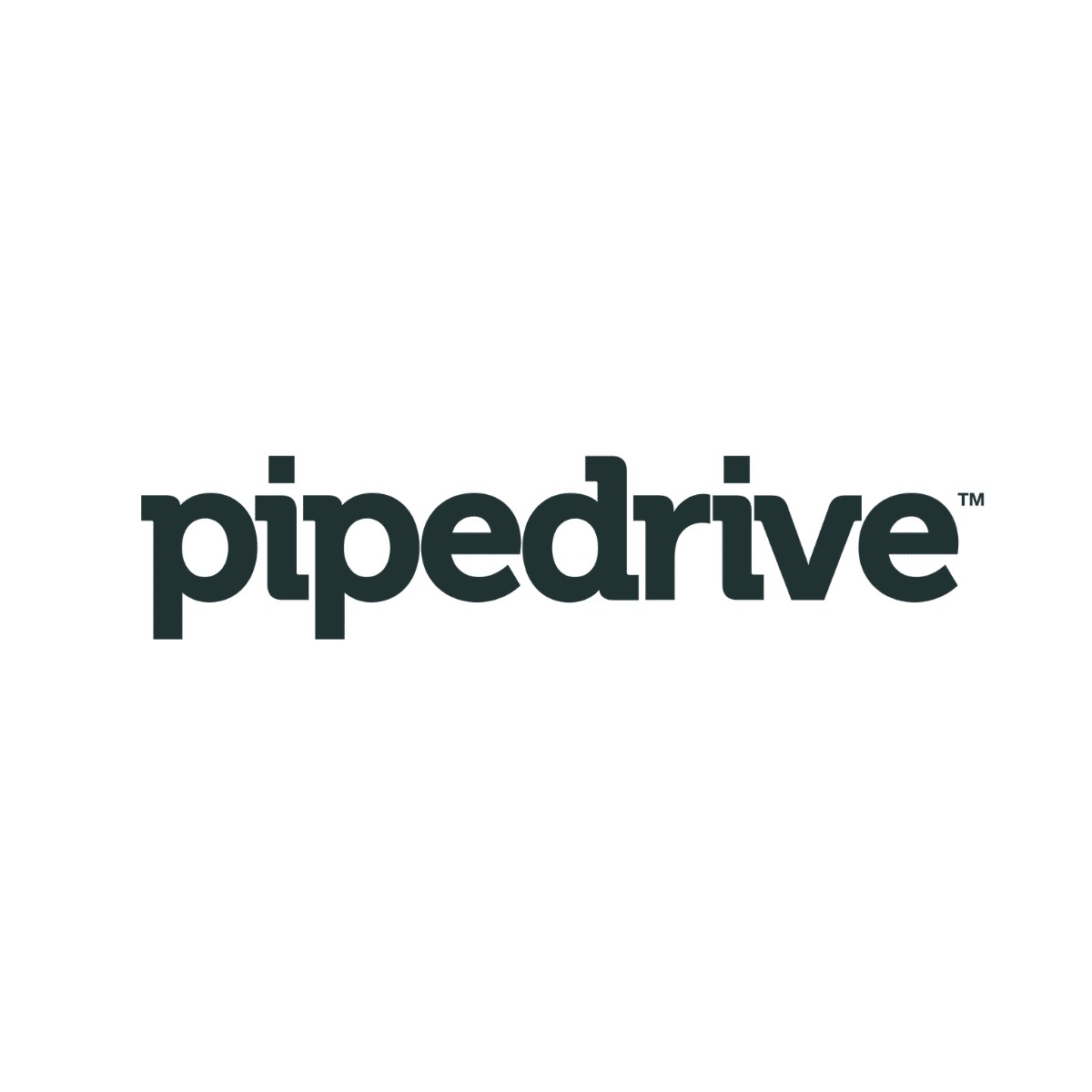Finding the perfect customer relationship management (CRM) is like finding a diamond in the rough.
With so many options available, it’s easy to choose a dud, causing lost revenue, mismanaged leads, and frustrated employees.
I’m AJ, here to help narrow it down! I’ve built my business over the last decade, figuring out what works (and what doesn’t).
After a successful multiple seven-figure exit, I acquired Small Business Bonfire (SBB) to help fellow entrepreneurs succeed (in half the time it took me).
So, let’s talk about two of my all-time favorite CRM platforms to recommend—HubSpot and Pipedrive.
Both platforms offer best-in-class features, but only one can come out on top!
How Did We Evaluate Pipedrive and HubSpot?
We put Pipedrive and HubSpot CRM through their paces in terms of the following:
- Pricing & Free Version
- Top Features
- Customer Service
- Integrations
- Ease of Use
- Best Mobile App
- Knowledge and Learning Center
- Limitations
- Which One We Think is Best for Small Businesses
How We Objectively Test Each Platform:
AJ's got a knack for kick-starting businesses, putting them on autopilot, and setting them up for acquisition. Over the past decade, he's been right in the thick of things with hundreds of small businesses, helping them with just about everything under the business sun. If you need advice on software suites and choices? AJ's your guy.
We roll up our sleeves and dive into the top CRM features we think are pretty crucial for small businesses. Stuff like reports and analytics, options to customize your pipelines, and the ability to link up with other apps and services. We know what makes small businesses tick, so we know what features they need to get the job done.
Money matters, folks! When it comes to picking a CRM system, price is usually the deal-breaker. We give a big thumbs up if a provider charges $30 or less per user each month for their starter plan. Extra brownie points for throwing in a freebie plan or trial, options to scale up or down as needed, and the freedom to pay monthly or yearly. We're looking for flexability for small businesses.
We all know support is mega important when you're choosing a CRM platform. This is especially true for those smaller businesses or sales teams who can't afford to have tech wizards on their payroll. We put our detective hats on to see if these companies offer round-the-clock support, and we looked at the different ways you can get help. We're talking live chat (like, real-time convo), email tickets, a good old-fashioned phone call, and self-service tools (for the DIY-ers out there).
When you're in the business of picking a CRM, integrations are like the secret sauce that takes your burger from 'meh' to 'mind-blowing'. Imagine, all your favorite apps and tools, working together in perfect harmony, making your workflow smoother than a fresh tub of Nutella. When we review a CRM, we look at the integrations most SMB owners are looking for.
When you're reviewing a Customer Relationship Management (CRM) system, it's essential to pay close attention to its ease of use. After all, a CRM is as beneficial as its usability. A simple, intuitive interface saves you and your team a great deal of time and headache. When we're reviewing each CRM, this is a crucial aspect that we look for.
The importance of Mobile CRM cannot be overstated in today's digital age. It's essential for fostering strong customer relationships and managing business activities. Mobile access to CRM makes it possible for sales teams to update and access customer information in real time, improving efficiency and ensuring up-to-date data. Mobile CRM can have a massive impact on SMBs, so thoroughly testing it is essential for each one of our reviews.
HubSpot Vs. Pipedrive Comparison Chart
We put Pipedrive up against HubSpot in a winner-take-all matchup. Here are the results.
HubSpot Vs. Pipedrive: Pricing
Let’s see how HubSpot fares against Pipedrive when it comes to pricing.
Pipedrive Pricing
Pipedrive offers a free plan in addition to three paid plans:
- Essential: $21.90/Month
- Advanced: $37.90/Month
- Professional: $59.90/Month
- Power: $74.90/Month
- Enterprise: $119.00/Month
Check out our complete Pipedrive pricing guide.
HubSpot CRM Pricing
HubSpot CRM offers a free plan in addition to three paid plans:
- Free Plan – Free Forever
- Starter CRM Suite – $30/month
- Professional CRM Suite – $1,335/month
- Enterprise CRM Suite – $5,000/month
Pipedrive Vs. HubSpot Pricing Winner: Pipedrive
AJ’s Take: While HubSpot may have a free plan, Pipedrive offers more affordable paid plans with a wider range of features to choose from. Pipedrive is the winner in terms of pricing.
Pipedrive Vs. HubSpot: Top Features
Let’s dig into the top features of each platform to see which one offers the most value for small businesses.
HubSpot Top Features
In this section, we explore HubSpot’s top features and what they bring to the table for small businesses.
Pipeline management is a crucial aspect of your sales process, and HubSpot offers a clean, visual sales pipeline to keep track of your deals (courtesy of HubSpot Sales Hub).
You can easily create, customize, and manage sales pipelines with HubSpot CRM.
Plus, the powerful sales software allows for full customization of your pipeline dashboard (shown below).
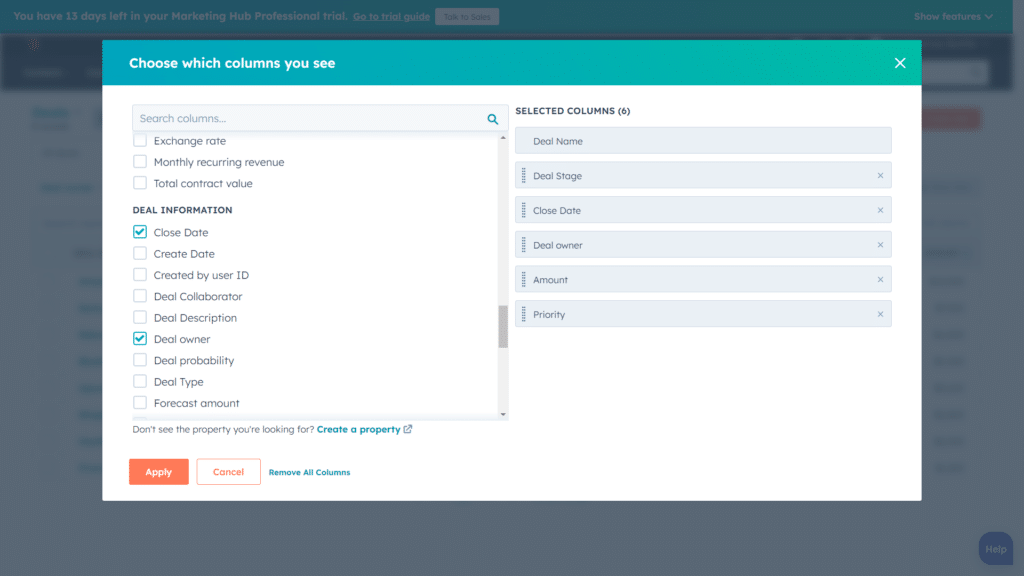
We tested this feature (over six months) by adding in some of our affiliate marketing contacts.
Some things we loved about HubSpot’s pipeline management include the following:
- Pipeline customizability
- Ability to segment deals by sales rep, stage, and tags
- Drag-and-drop functionality for easy deal customization
- Clear visual representation of pipeline health (e.g., deals won vs. lost)
Take a look at our deals pipeline (once we had all of our partnerships added.)
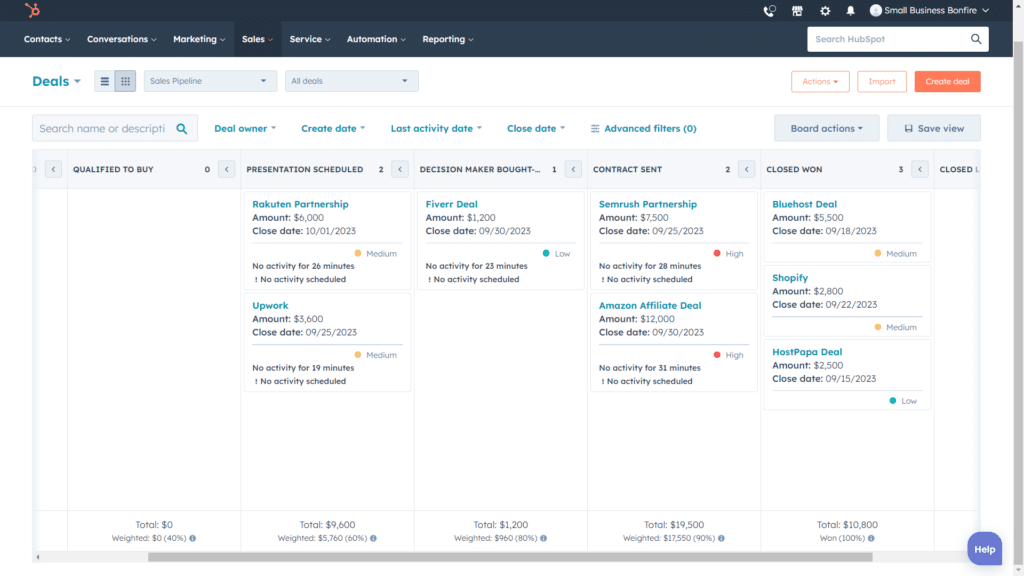
As you can see, the layout is clear and easy to read. We liked that each deal card clearly showed the priority level (with color coding).
This meant that nothing fell through the cracks as our teams took names and closed deals.
So, if you’re serious about scaling your sales efforts, we recommend you check out HubSpot.
Have you ever scheduled a meeting and had only half your team show up on time?
Well, if not, lucky you. But for the rest of us, scheduling meetings can be a hassle.
That’s why we love HubSpot’s meeting scheduling feature.
It allows for automatic syncing with your calendar, making it easy to schedule and keep track of meetings with team members and clients (even while on the go).
Here’s an example of a company meeting we were able to schedule in just a couple of minutes.
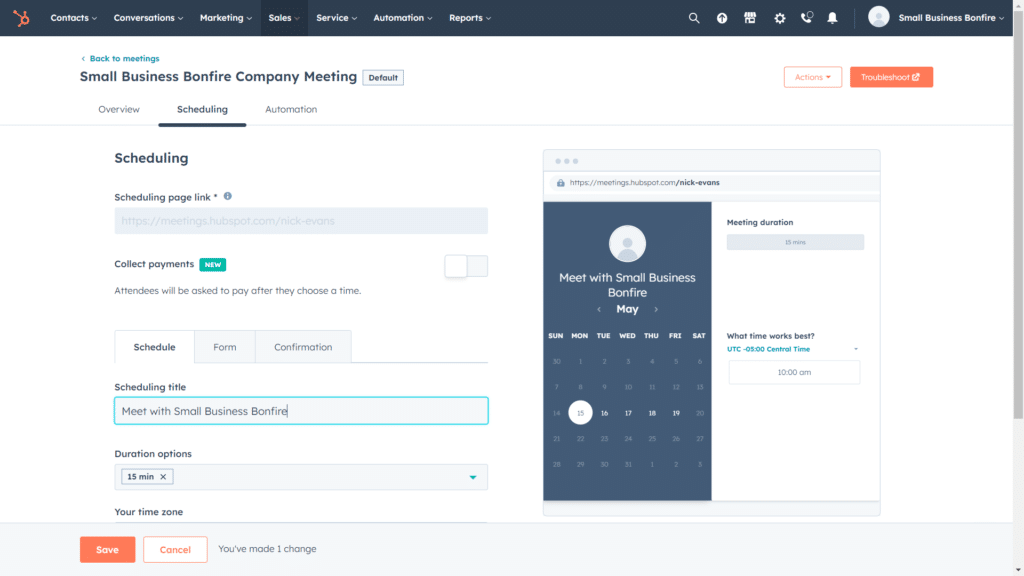
We selected a date and time, set the duration, and invited our team with a link—simple as that.
While it’s maybe not the flashiest feature a CRM offers, it’s certainly one of the most useful (and time-saving!).
Managing your customer queries can be a challenge without the right tools.
Luckily, HubSpot offers a robust support ticketing system (that’s completely free) to help streamline your customer service process.
Not only can you create and manage all support tickets within the CRM, but you can also automate responses and track issue resolution.
Here’s a screenshot of our support ticket dashboard (after we had a few inquiries from our clients).
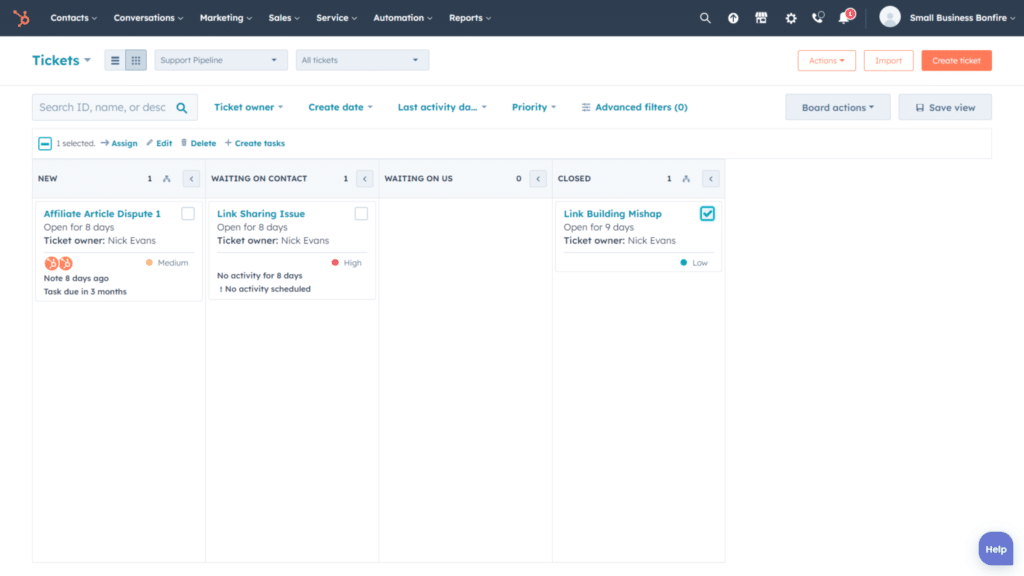
We appreciated having all of our tickets in one convenient place, making it easy to resolve issues as they arose.
We also really liked the ability to customize our ticket boards from top to bottom.
We were able to customize the following with HubSpot:
- Status name
- Open or closed
- Status properties
- Ticket cards
- Ticket tags
Here’s how the customization looked during our six-month testing period.
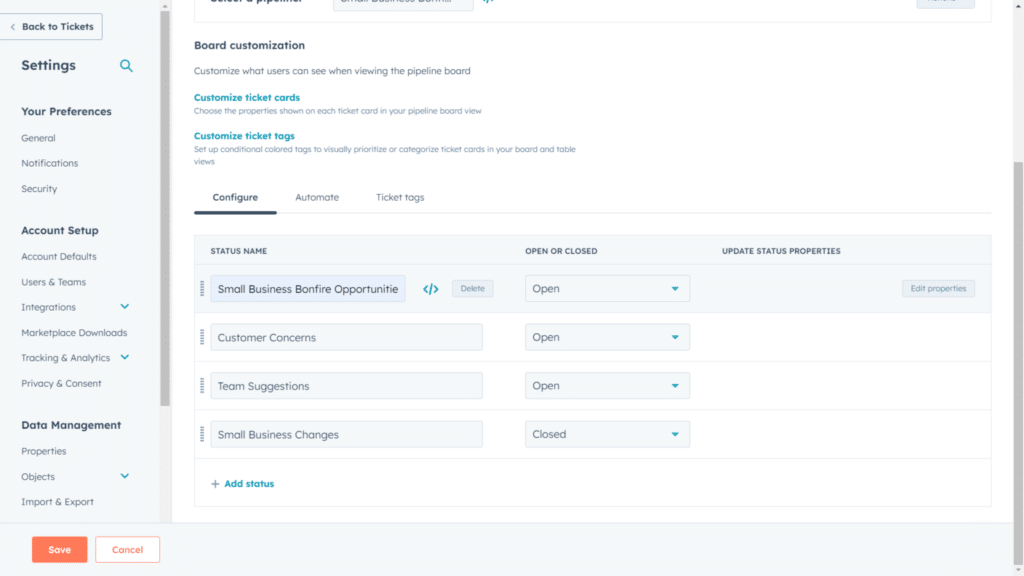
The bottom line: Ticket management can help you stay organized and deliver better customer service, leading to happier, more loyal customers.
So, if you want to ramp up your service game, give HubSpot a try (and you can thank us later).
Understanding your clients is crucial for business success, and one great way to do this is through feedback surveys.
With HubSpot, you get an amazing feature that lets you quickly create and send robust feedback surveys.
It’s super user-friendly and allows you to create detailed surveys that suit your needs perfectly. We absolutely loved this feature’s versatility and depth during our test period.
With HubSpot, we were able to create the following types of surveys:
- Customer support
- Customer satisfaction
- Customer loyalty
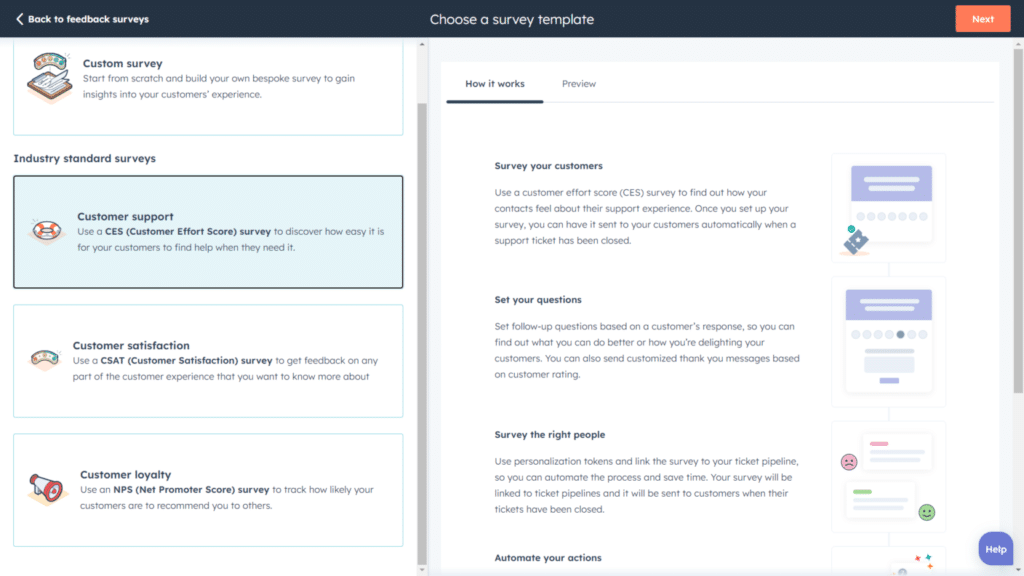
These surveys helped us gather valuable insights directly from our clients, such as the following:
- How they view our SBB & our services
- Where we could improve
- Areas that we excel in
Customer feedback is essential to scaling. After all, you can’t learn from your mistakes if you don’t know what they are.
HubSpot provides you with a powerful, easy-to-use survey feature to help keep your finger on the pulse of your customers.
In today’s fast-paced business world, live chat is a must. If you’re not connecting with your clients instantaneously, chances are someone else is.
You’ll need a robust live chat feature that integrates seamlessly with your CRM (to stay ahead of the curve).
Enter HubSpot’s Live Chat.
We were able to easily set up a live chat widget on our site using HubSpot (shown below).
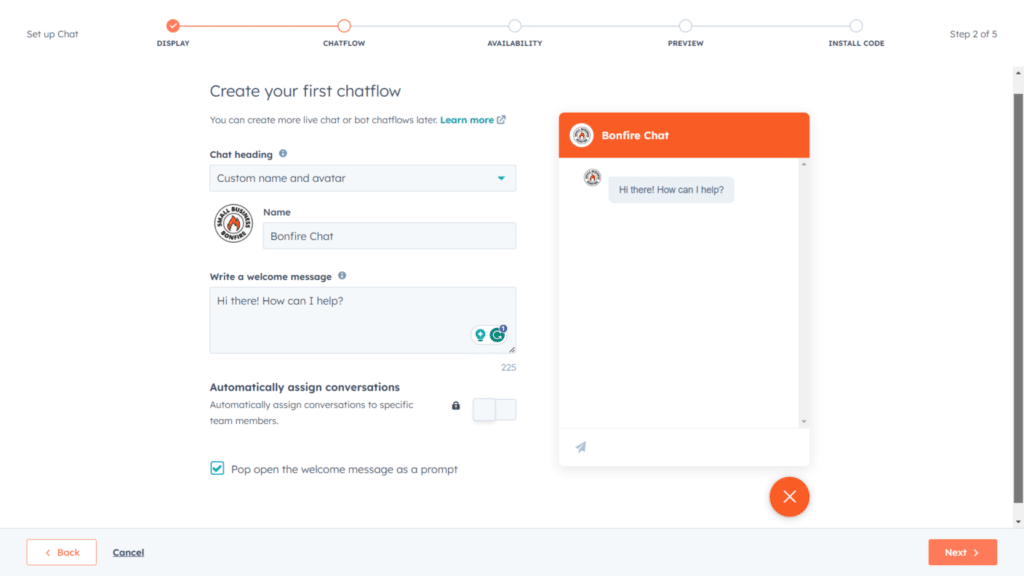
Adding our logo and custom colors only took a few minutes, and we were set!
During our testing period, we could send and receive messages easily through this messenger (on both desktop and mobile).
We could also add in canned responses for commonly asked questions, saving us a ton of time.
The cherry on top was that we could view each message and the corresponding contact in our CRM, making it easy to keep track of customer interactions.
HubSpot’s content management system, CMS Hub, is a game-changer when it comes to content management.
With this feature, you can easily create and manage multiple websites (all within the CRM tool).
It is user-friendly and offers a wide range of templates (as seen below) to help you get started.
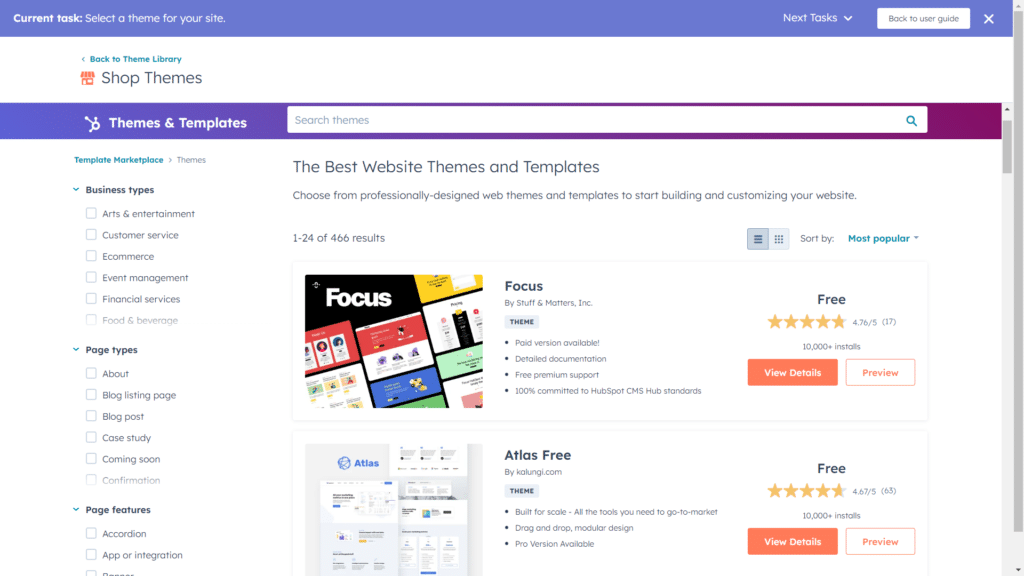
Most of these templates are 100% free, meaning you can create stunning web pages without paying a dime.
We could choose our color scheme and text (pictured below) with just a few clicks.
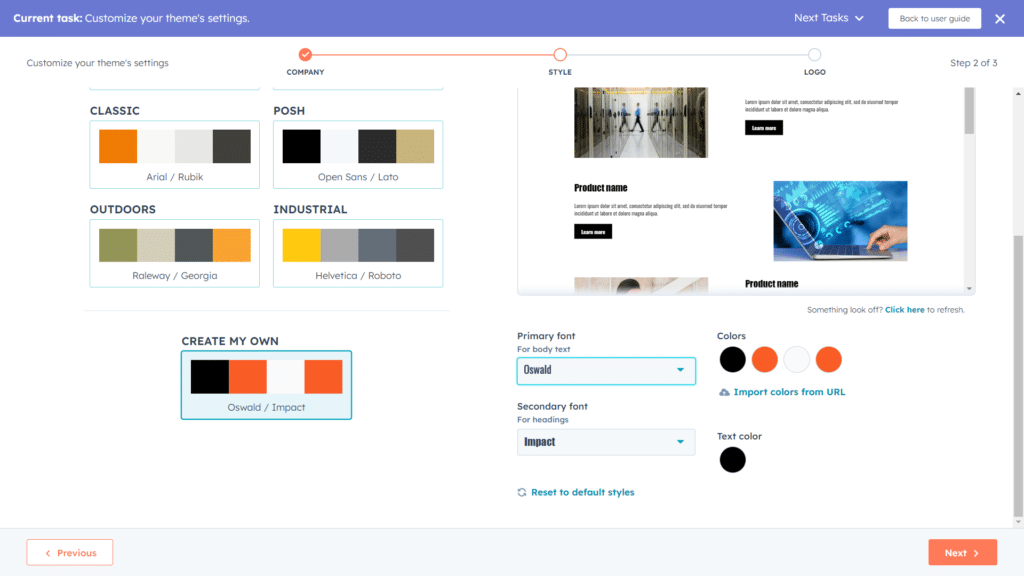
Once we had everything set up, we were taken to a fantastic editor to create our site.
Here’s a sneak peek into our creation process (about halfway through).
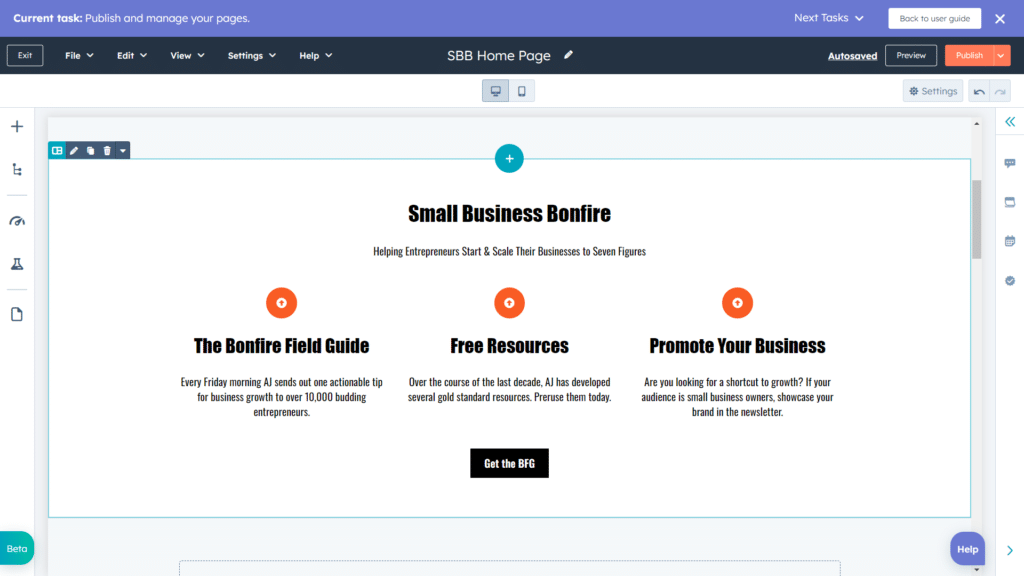
We particularly liked the drag-and-drop functionality for building pages and the ability to preview changes before publishing.
Plus, with HubSpot’s SEO tools, we could identify and fix potential optimization issues before going live.
Our only complaint with this feature would be that there’s not a ton of customization for your web pages (compared to some other options on the market).
Email marketing is essential if you’re looking to reach your audience and promote your brand.
HubSpot’s email marketing tools make it easy to create and send personalized emails to your contacts (directly within the CRM).
Let’s walk you through our testing process for this feature (over six months).
First, we navigated to the helpful email templates (shown below) to start creating our first email campaign.
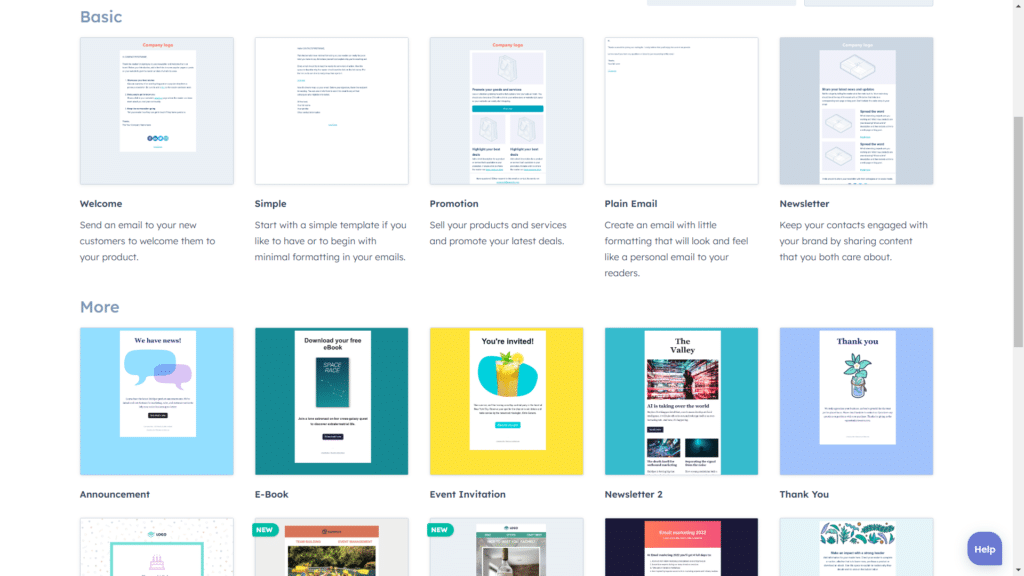
These templates are perfect for anyone new to CRM who needs help getting off the ground.
We were able to customize each template with our branding, images, and messaging in just a few clicks.
Here’s a quick follow-up email we created within seconds using HubSpot’s email marketing tools.
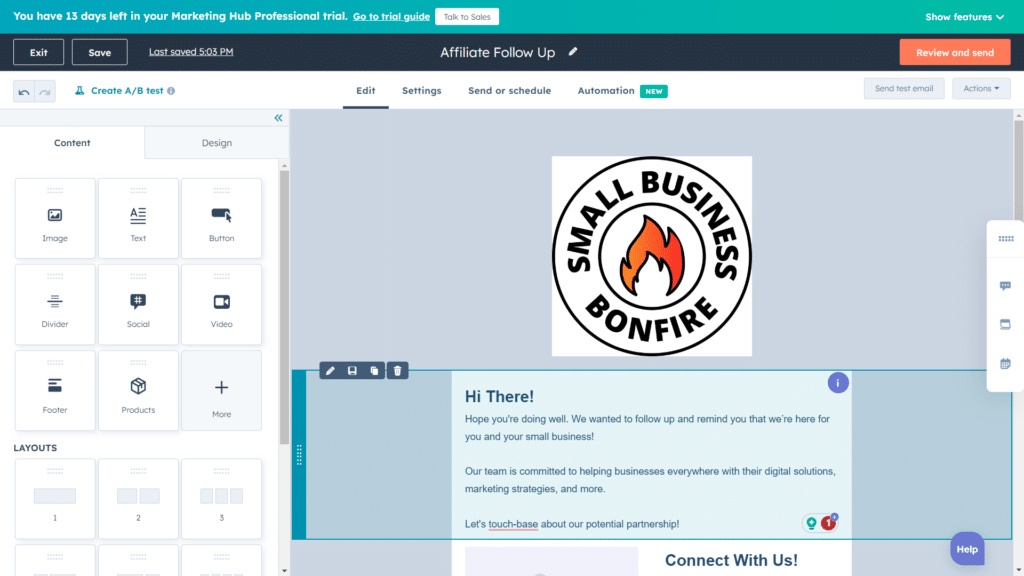
We were able to easily segment and target specific groups of contacts for our email campaigns (which helped improve our open rates and overall engagement).
But what impressed us most was the marketing automation capabilities of HubSpot.
We could set up automated workflows based on specific triggers (such as website visits or form submissions).
And with the ability to track and analyze campaign performance in real time, we were able to continually optimize and improve our email marketing strategy.
To say it was awesome would be an understatement.
The bottom line: If you’re serious about marketing, HubSpot should be at the top of your list.
With its powerful email marketing and automation tools, you can save time and effort (while delivering impactful campaigns to your audience).
Make manual tasks a thing of the past with HubSpot’s automation capabilities.
We were amazed by how easy it was to set up automated workflows for various tasks (such as email notifications or task assignments).
We created tons of automations using their helpful templates (pictured below).
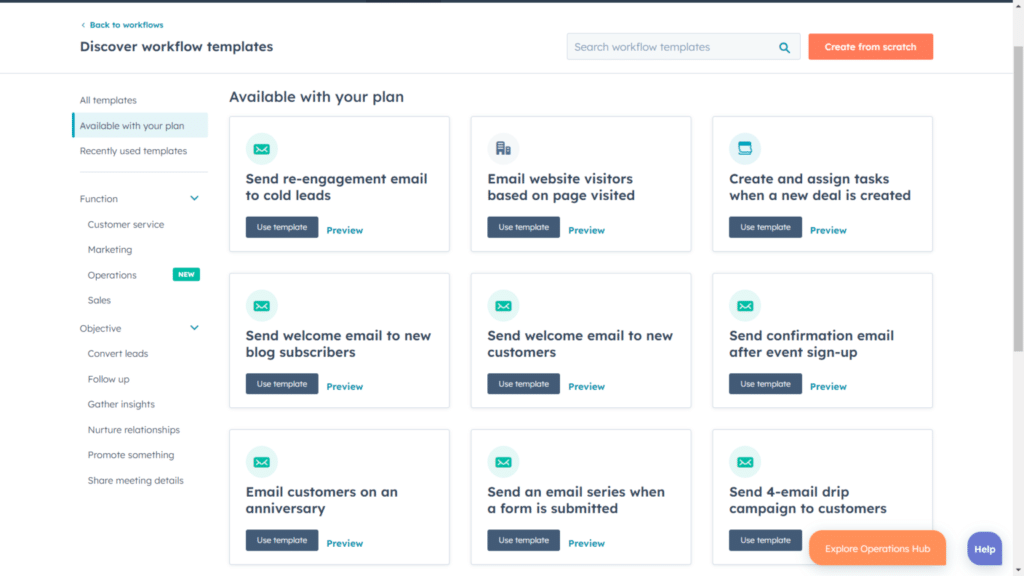
These templates essentially eliminated the need for any coding or advanced technical skills.
Plus, we could easily customize workflows to fit our specific needs and goals.
For example, we created a quick automation that capitalized the first letter of each client’s first and last name.
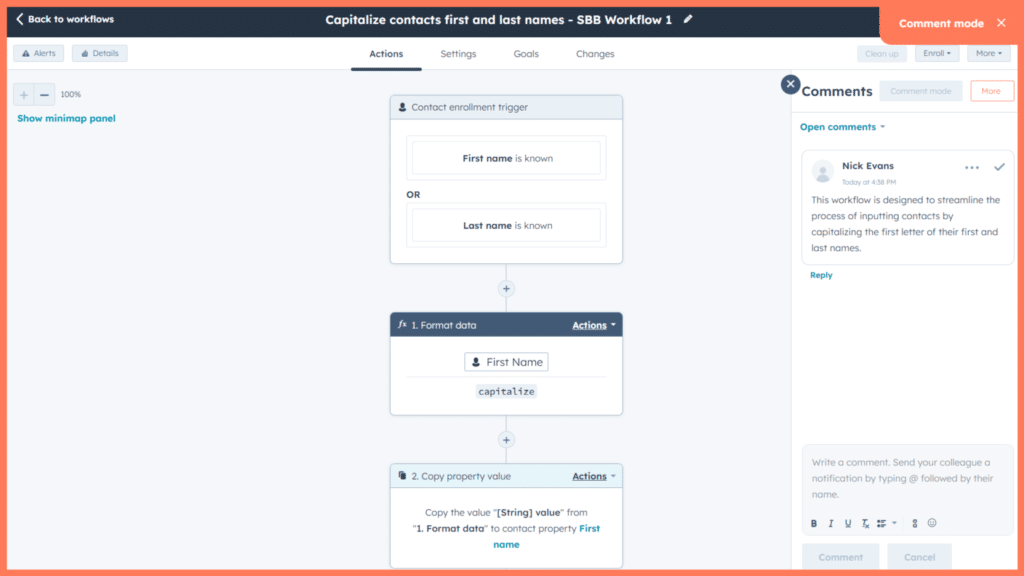
This one little automation saved countless time for our sales team while quickly inputting data. It also ensured that there was very little room for error.
Here are some other types of automation we created with HubSpot:
- Follow-up emails after a form submission
- Automatic lead assignment based on specific criteria
- Task reminders for important deadlines
The brass tacks: We were thoroughly impressed with HubSpot’s automation capabilities. It truly streamlines processes and increases efficiency for SMBs.
Pipedrive Top Features
Let’s look at some of the key features that make Pipedrive a top choice for SMBs
Pipeline management is what Pipedrive focuses on first and foremost.
Pipedrive provides a simple, visual way to track, manage, and customize your pipelines.
Let’s go through our experience using Pipedrive’s pipeline management (to give you a better idea).
To begin, we clicked the “+ Deal” button (shown below).
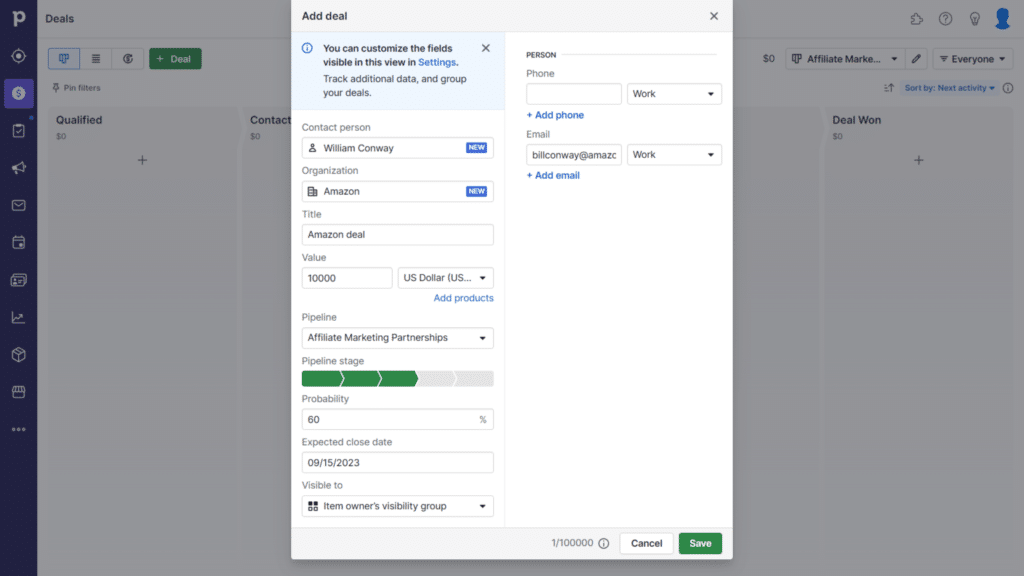
From there, we were able to fill out each aspect of our deals, including the following:
- Contact associated
- Organization
- Title
- Value
- Pipeline
- Stage in pipeline
- Probability %
- Contact information
That’s a lot of helpful information for such a simple process.
Once we had our deals set up and organized, we could easily drag and drop them into different stages as they progressed (pictured below).
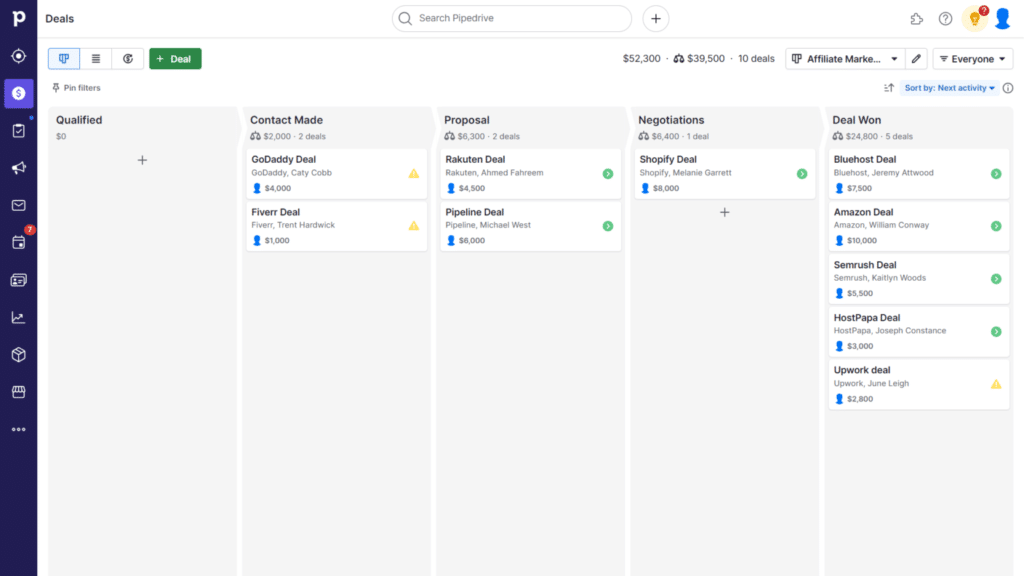
We really liked the visual aspect of this pipeline management system, as it made it easy to see where each deal was in the sales process.
We also loved that we could easily click each deal and schedule an activity (directly from the pipeline).
Here’s how it looked during the testing period.
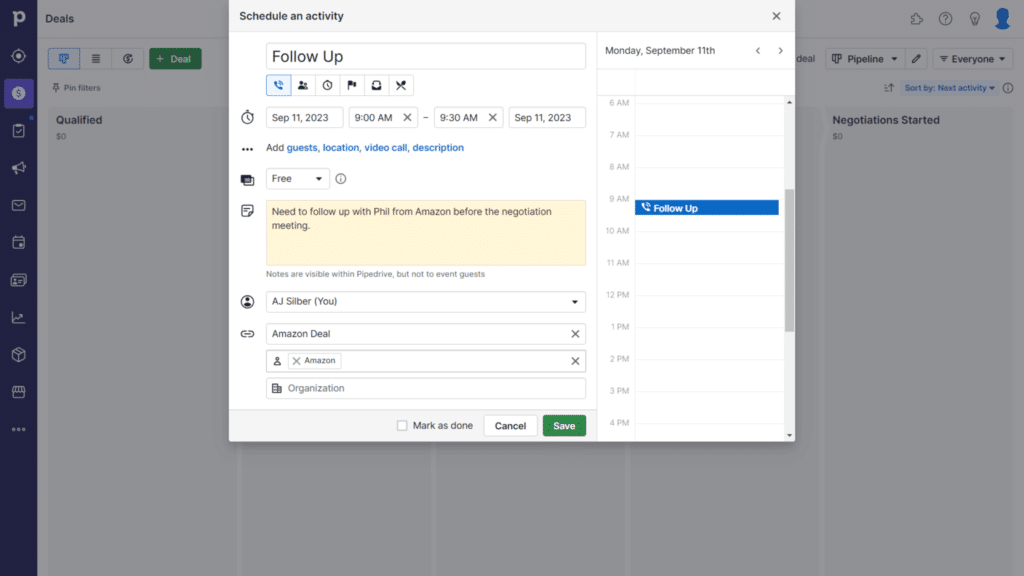
Being able to easily assign tasks, meetings, and other activities to each card made the follow-up process effortless.
The scoop: With Pipedrive, we were able to stay organized and on top of each deal without any hassle.
There’s a reason why we say Pipedrive is among the best pipeline management on the market.
Pipedrive offers some fantastic project management capabilities to help keep your marketing and sales teams on track while tackling projects.
It’s worth noting that this feature costs an additional $6.70/month (but we think it’s well worth it).
With Pipedrive’s project management tools, we were able to accomplish the following:
- Create and assign tasks to team members
- Set due dates and priorities for each task
- Track progress on each project
- Communicate with team members directly within the platform
- Receive notifications for updates and changes in real-time
We especially liked their project templates, which let us create a standardized process for each type of project we worked on.
That way, we didn’t have to create ten different onboarding projects throughout the year (each time we hired new team members).
Here’s an example of how a project template looked during the customization stage.
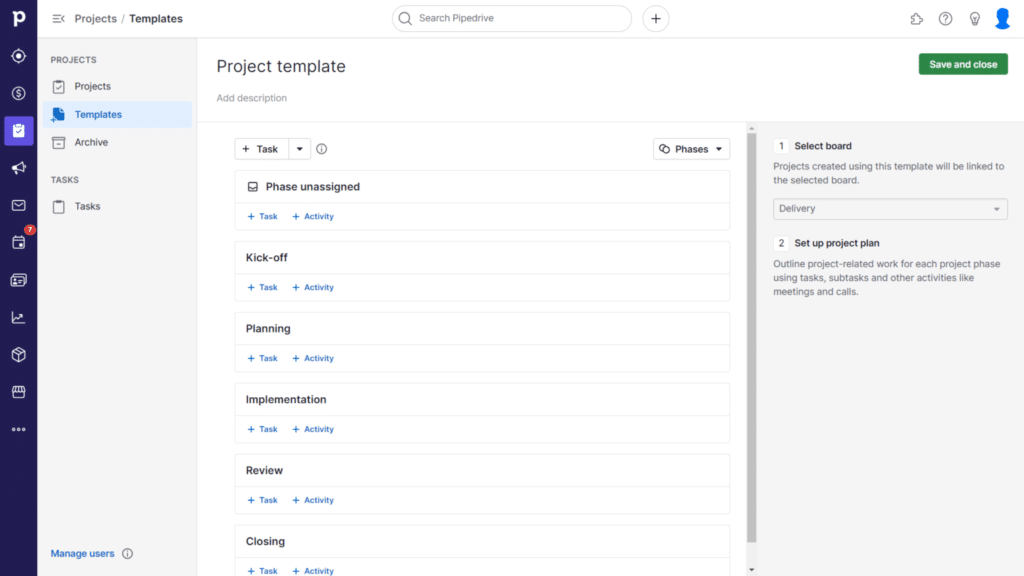
Check out how a “new project” card looked from our Bonfire Field Guide rollout project that we managed with Pipedrive.
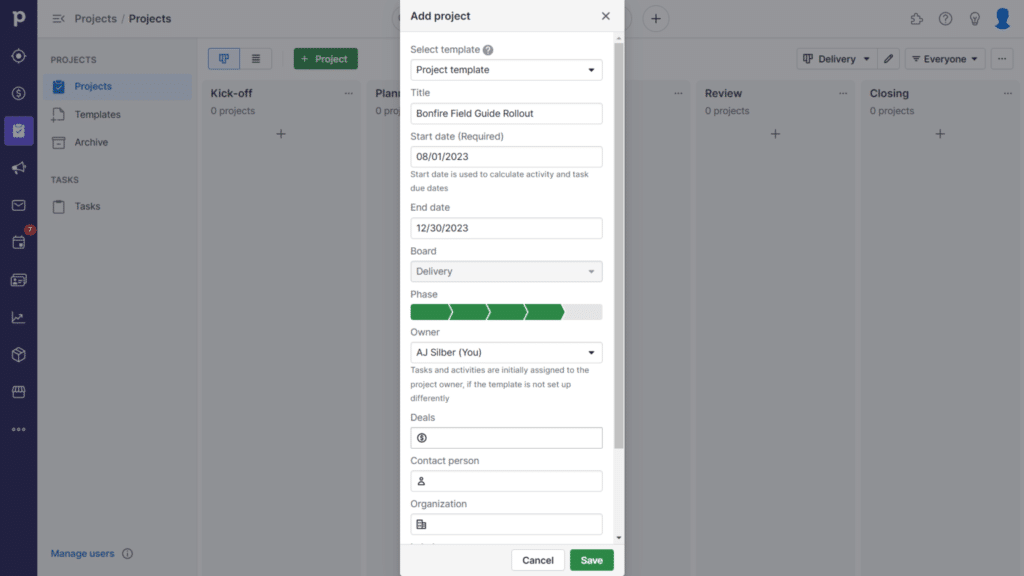
Each card offers a ton of useful information (without being overwhelming) to keep your team on track and in the know.
Our takeaway: If you’re tired of juggling multiple project management tools, Pipedrive offers a simple and intuitive solution.
You can keep everything in one place and easily collaborate with your team (without any added stress or confusion). The only downside that we saw was the extra price tag associated with it.
Pipedrive’s workflow automation is as effective as it is innovative.
Here’s a quick overview of the features we found most useful:
- Progress bars: These visual representations of your workflows provide an instant snapshot of how far along you are in each task or project. Seeing progression in real-time not only helps keep everyone updated but also motivates the team to drive tasks to completion.
- Notifications: Staying informed is never an issue with Pipedrive’s timely notifications. Whether it’s about task updates, deadlines, or status changes, these alerts keep you in the loop, enabling you to react promptly and ensuring that nothing slips through the cracks.
- Custom workflows: Pipedrive lets you design workflows that align with your business processes. Whether it’s a simple task sequence or a complex sales pipeline, you can customize every aspect of your workflow. This flexibility allows you to streamline processes, improve efficiency, and drive productivity.
To sum it up, Pipedrive’s workflow capabilities are not only robust and flexible, but they are also very user-friendly.
These features are perfect for businesses seeking to simplify operations and maximize productivity.
If you’re in the market for some powerful email marketing campaigns, look no further than Pipedrive!
In addition to all of the powerful CRM features the platform provides, you can also add on campaign creation for an extra $16/month.
Here’s what we loved about Pipedrive’s campaign feature:
- Easy email builder: We created professional-looking emails in minutes thanks to Pipedrive’s drag-and-drop email builder. This feature is perfect for businesses that don’t have a dedicated design team, as it allows you to easily customize templates and add your branding.
- Advanced segmentation: Pipedrive offers advanced segmentation capabilities, allowing you to target specific audience segments with personalized messages. This level of personalization can increase engagement and conversions significantly.
- Automated campaigns: With Pipedrive’s campaign tool, we were able to automate our email marketing efforts. From welcome emails to follow-ups and promotions, we could schedule and send automated emails at predetermined times or based on specific triggers.
Plus, you don’t have to start from scratch; Pipedrive provides some great templates to help you get started (screenshot below).
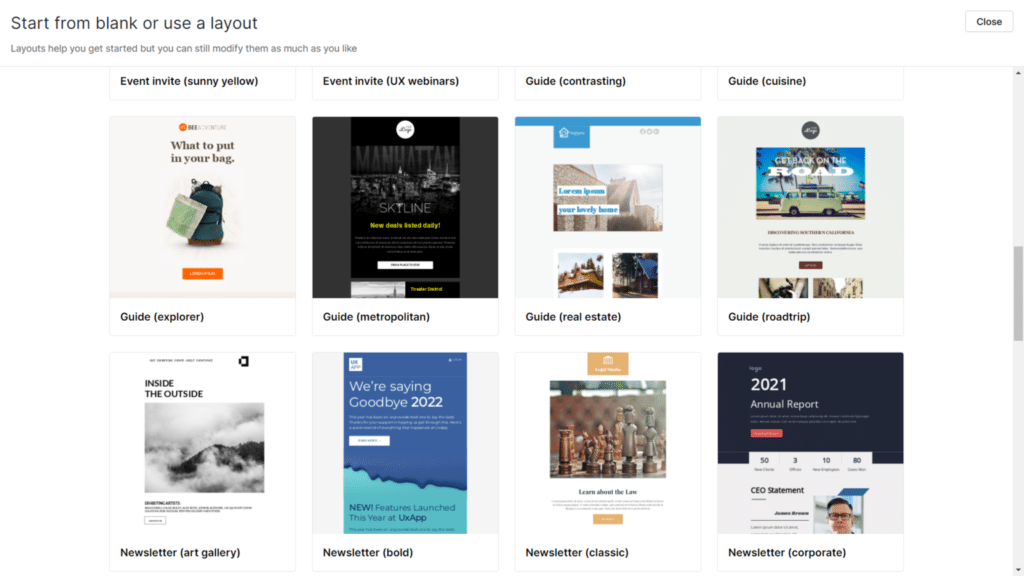
We used this feature extensively during our six-month testing period, creating various campaigns.
Check out a template we created, introducing our Bonfire Field Guide to our audience.
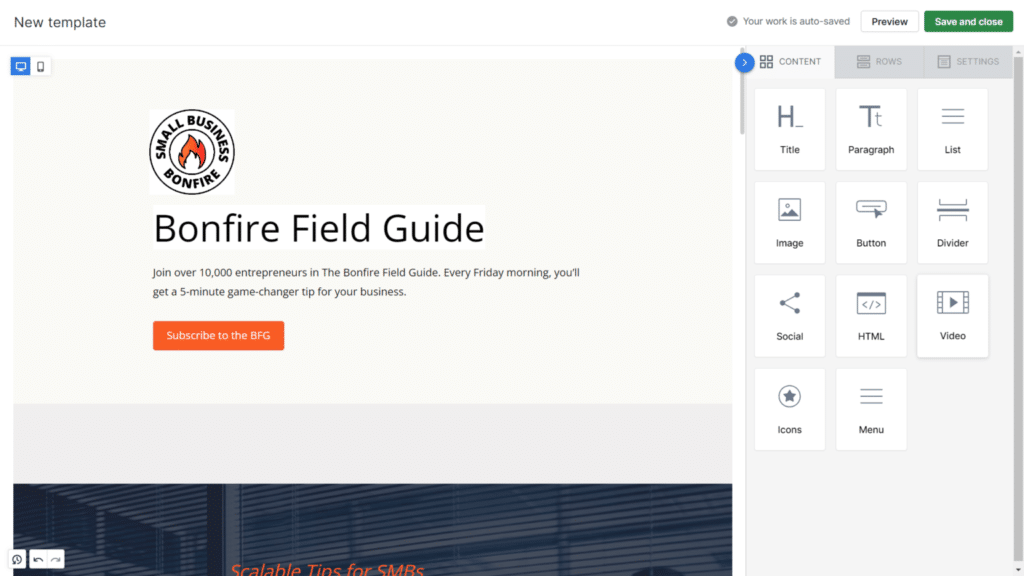
Pipedrive made it simple to create powerful campaigns with the drag-and-drop interface and helpful tutorial videos if we got stuck.
All that from a platform best known for pipeline management is pretty impressive!
Managing your customer relationships starts with organizing your customer data in one centralized location.
That’s where Pipedrive’s customer data management comes in.
Here are some of the features we found most useful:
- Customizable contact fields: You can customize your contact fields to suit your business needs and gather all the information you need from your customers. This feature allows you to create a thorough customer profile with all the relevant data in one place.
- Import/export data: Pipedrive makes importing and exporting customer data easy, ensuring a smooth transition from your previous CRM or spreadsheet. You can also use this feature to back up your data for added security and peace of mind.
- Integrations: With over 150 integrations available, you can connect Pipedrive to your favorite tools and platforms to streamline your workflow and make data sharing even more convenient.
We really liked the sleek and easy-to-read contact cards (shown below) that let us view our customer’s information at a glance.
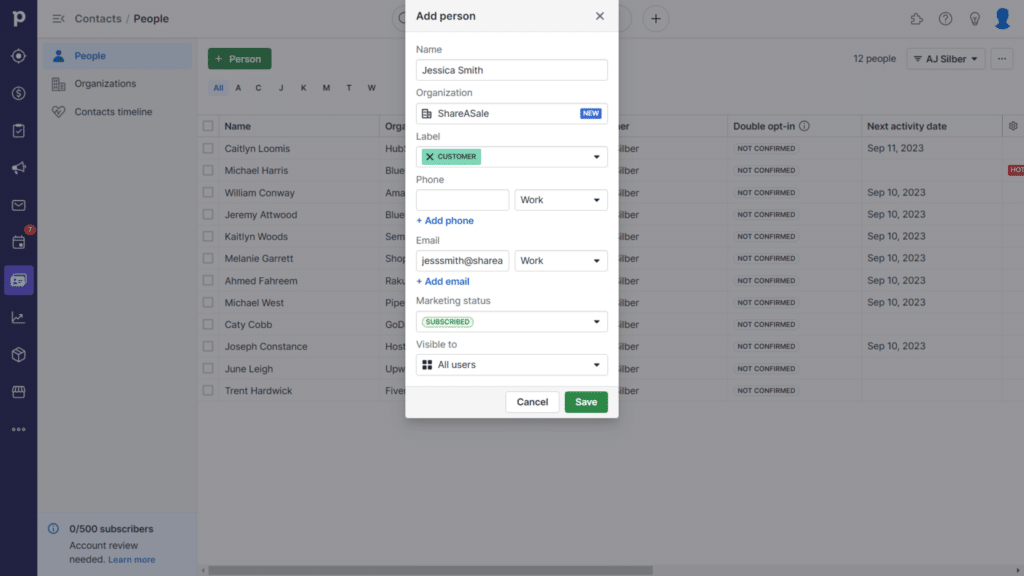
It made it easy to quickly access important details and notes (to provide personalized service).
Overall, we found Pipedrive’s customer data management system to be user-friendly and efficient.
It helped us keep all of our customer information organized and easily accessible, ultimately improving our relationship management process across the board.
Managing your daily activities is necessary for business owners of all shapes and sizes.
That’s why we’re happy to say Pipedrive offers a fantastic activity-tracking feature to keep you on top of your tasks and appointments.
Here’s an example of a meeting we were able to create (in seconds) for one of our affiliate marketing clients.
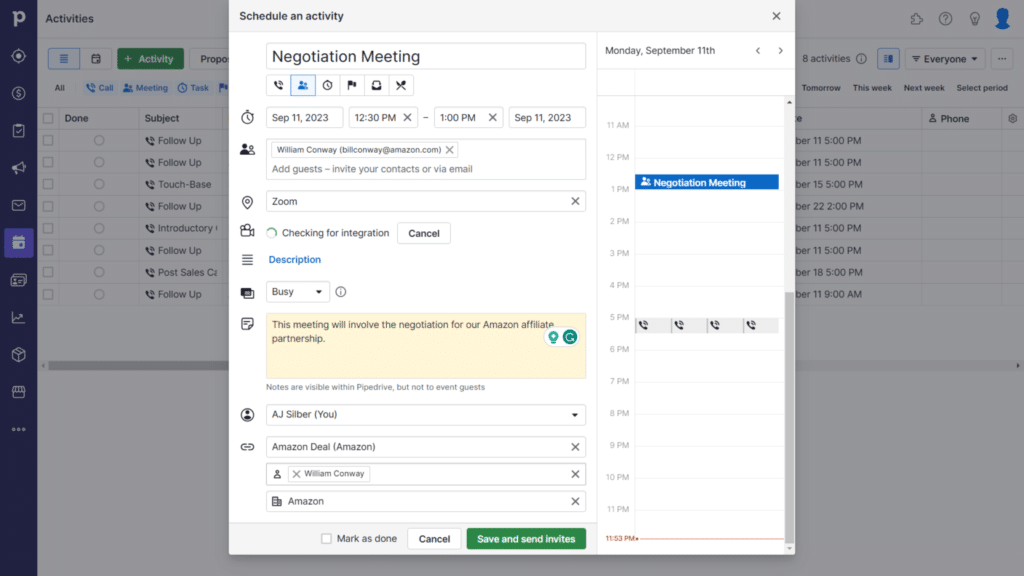
We were able to easily add and edit the following info:
- Date
- Guests
- Meeting location
- Notes
- Associated companies
- Assigned users
From there, we could send out invites to the meeting, and it went off without a hitch!
Our takeaway: Pipedrive’s activity tracker helps you stay organized and on top of your tasks while ensuring that nothing falls through the cracks.
Its user-friendly interface and customizable features make it easy to see why Pipedrive is the preferred choice for many SMBs looking to improve their daily operations.
One of the standout features of Pipedrive is the lead management add-on—LeadBooster.
This powerful prospecting tool is a game-changer for businesses looking to capture and nurture leads like a pro.
Here are some of the key features included with LeadBooster:
- Chatbots: Automate your lead generation with chatbots. They can handle routine interactions, freeing your team to focus on more complex customer queries.
- Live chat: This feature allows you to interact with visitors on your website in real time, answer their questions, and guide them toward making a purchase.
- Prospector: This feature offers you a pool of high-quality, verified leads to choose from. You can filter by industry, location, and company size to find the best leads for your business.
- Web forms: Capture leads directly from your website with customizable web forms. You can collect all the details you need to follow up and qualify the lead.
While LeadBooster brings immense value to your sales performance, remember that this feature comes at an extra cost of $32.50/month.
But considering the potential it has to skyrocket your lead generation efforts, it’s an investment worth making!
HubSpot Vs. Pipedrive Features Winner: HubSpot
AJ’s Take: While Pipedrive has some excellent features, HubSpot’s comprehensive suite of tools ultimately takes the lead. From its powerful email marketing capabilities to its advanced segmentation and automated campaigns, HubSpot offers a more well-rounded CRM experience for SMBs.
After testing, we compiled a thorough list of our favorite CRMs for Small Businesses. Check it out now! The list might surprise you.
HubSpot Vs. Pipedrive: Customer Service
For this section, we’ll compare each CRM platform in terms of the following metrics:
- Availability
- Knowledge base
- Training
- Responsive support
HubSpot Customer Service
Let’s see how HubSpot does in terms of customer service.
- Availability – HubSpot provides 24/7 live chat, phone, and email support. If you have a problem, chances are, they can help you.
- Knowledge base – HubSpot has a robust knowledge base with articles and guides to help you get the most out of the platform.
- Training – HubSpot offers extensive training materials, including webinars and helpful videos.
- Responsive support – With quick response times and helpful solutions, HubSpot’s support team is highly praised by its users. The max we waited to hear back was about 10 minutes (during a six-month testing period).
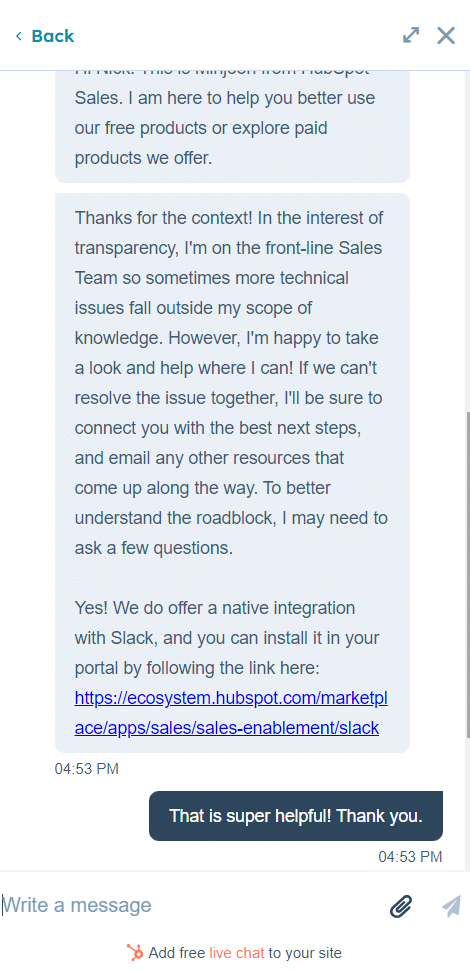
Pipedrive Customer Service
Now, let’s take a look at Pipedrive’s customer service offerings.
- Availability – Pipedrive provides 24/7 chat and email support, with phone support available during business hours. This ensures that you can always reach out for help when needed.
- Knowledge base – Pipedrive has a comprehensive knowledge base with articles and tutorials to help you navigate the platform.
- Training – Pipedrive offers various training resources, including webinars and a dedicated learning hub called Pipedrive Academy.
- Responsive support – Pipedrive’s support team is known for being responsive and helpful, with quick response times and efficient solutions. During our testing period, we received responses within 15 minutes or less.
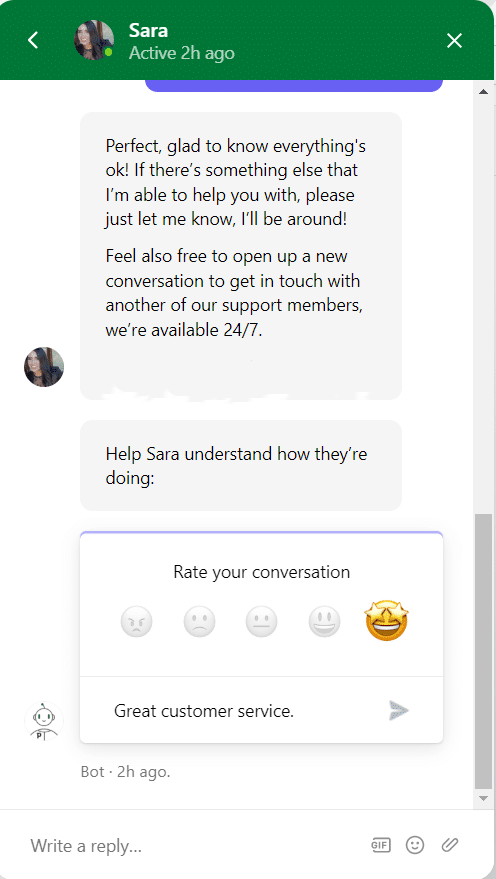
Pipedrive Vs. HubSpot Customer Service Winner: Tie
AJs Take: Both Pipedrive and HubSpot offer excellent customer service options to their users. While HubSpot offers more comprehensive training resources, Pipedrive’s responsive support team and easy-to-navigate knowledge base make it a close tie in this category.
Pipedrive Vs. HubSpot: Integrations
When it comes to integrations, both Pipedrive and HubSpot offer a wide range of options. However, there are some key differences worth noting.
HubSpot Integrations
When it comes to integrations, HubSpot is a powerhouse.
They’ve got almost every native integration you could think of, and even more via Zapier.
Some of our favorite integrations with HubSpot include:
- Slack
- MailChimp
- Zapier
- Trello
- Asana
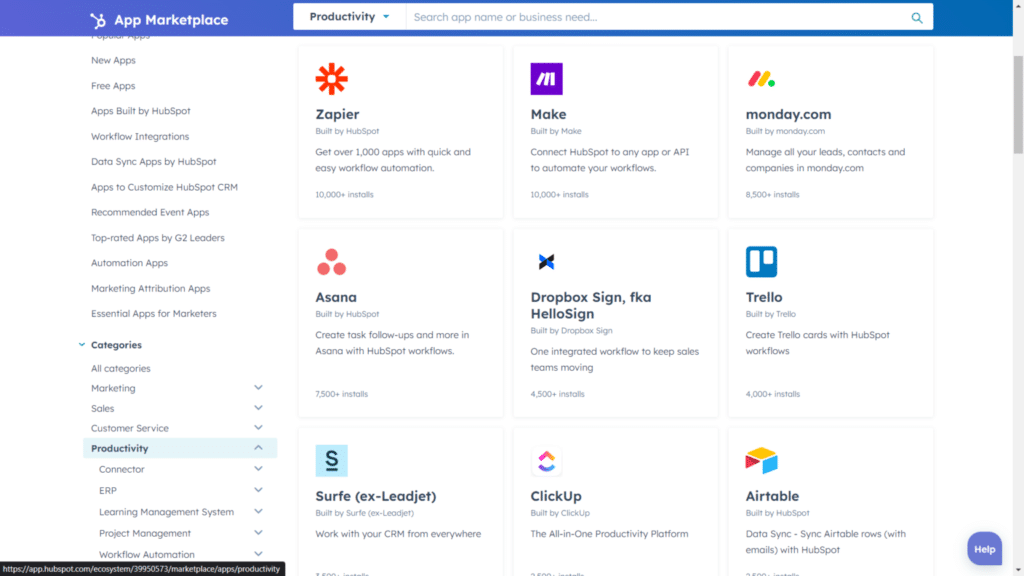
All in all, if you need a platform integrated with HubSpot, you’ll find it 90% of the time.
And if it’s not there, there’s probably a Zapier third-party integration available.
Pipedrive Integrations
Pipedrive offers some great integrations, both native and third-party, but it pales in comparison to HubSpot.
Some popular Pipedrive integrations include:
- Zoom
- Slack
- Zapier
- MailChimp
- Facebook Messenger
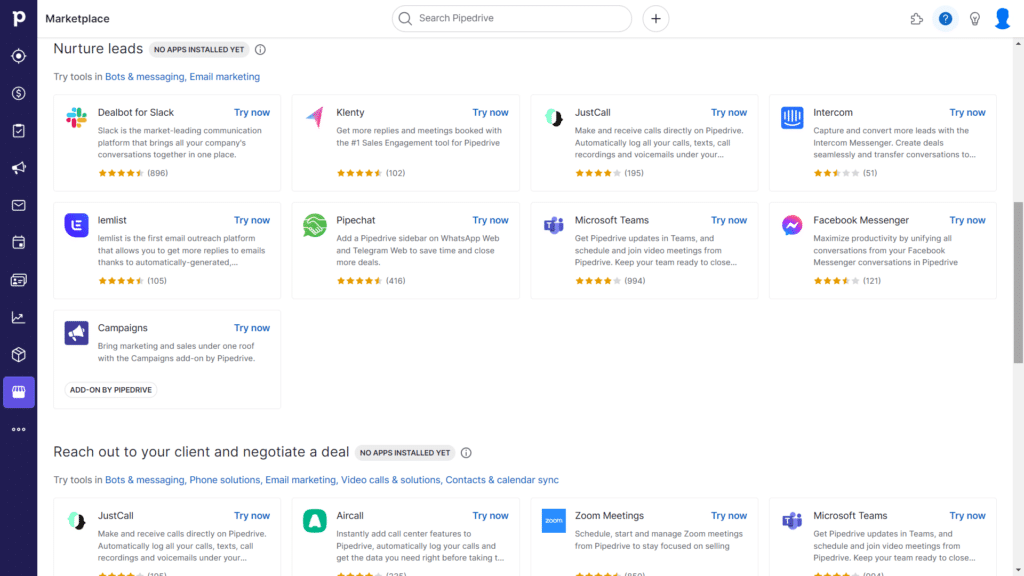
Overall, if you’re looking to integrate most platforms, Pipedrive has your back. However, if you want to take your integration game to the next level, we recommend HubSpot.
HubSpot Vs. Pipedrive Integrations Winner: HubSpot
AJ’s Take: While Pipedrive does offer some great integrations, HubSpot simply has more options available. Plus, with the added bonus of Zapier integrations, HubSpot is the clear winner in this category.
HubSpot Vs. Pipedrive: Ease of Use
Both HubSpot and Pipedrive are known for their simple and user-friendly interfaces. However, there are some key differences to consider.
HubSpot Ease of Use
HubSpot’s interface is intuitive and easy to use, with a dashboard that provides impressive sales forecasting.
Navigating through the platform is a breeze, and tasks such as adding contacts and creating deals can be done quickly and seamlessly.
HubSpot offers tons of helpful templates for everything from automation to email marketing campaigns. These make it easy for beginners to acheive pro level sales, marketing, and service.
Pipedrive Ease of Use
Pipedrive also has a user-friendly interface that’s easy to navigate.
It’s got some of the easiest and most comprehensive pipeline management of any platform we’ve tested (and that’s saying a lot).
Pipedrive Vs. HubSpot Ease of Use Winner: Tie
AJ’s Take: Both HubSpot and Pipedrive offer simple and user-friendly interfaces that make daily operations a breeze. This one is a tie!
Pipedrive Vs. HubSpot: Best Mobile App
When it comes to managing your sales on the go, having a user-friendly and efficient mobile app is crucial. Let’s see how HubSpot and Pipedrive stack up in this department.
HubSpot Mobile App
HubSpot offers a fantastic mobile app (with glowing user reviews) available on iOS and Android devices.
We downloaded the HubSpot app on iOS for our testing (over six months).
Some features we really liked include the following:
- Contact management
- Meeting links
- Deal management
- Task management
- Activity feed
- Ticket management
- Email marketing
With HubSpot’s app, we were able to access all of the platform’s key features and manage our sales process on the go.
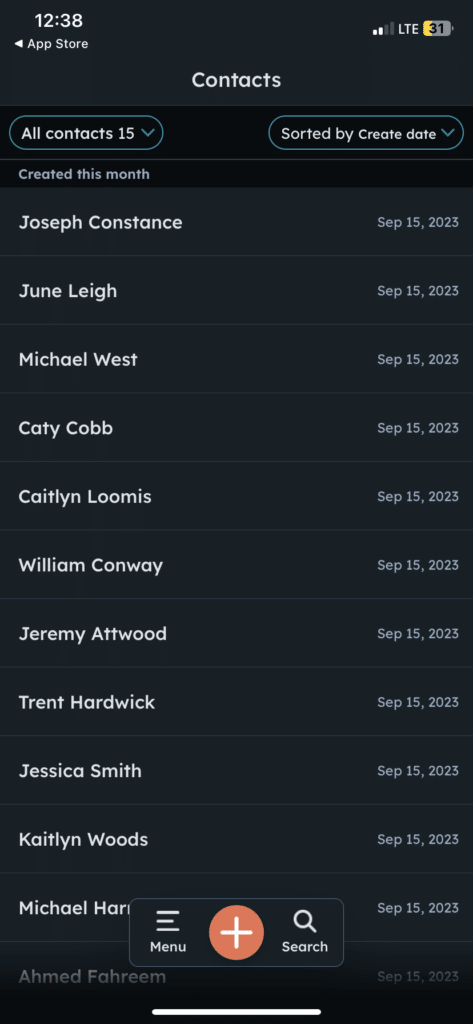
Pipedrive Mobile App
The Pipedrive mobile app is available on both iOS and Android devices, and it offers many similar features to HubSpot’s app.
Some standout features include:
- Deal management
- Contact management
- Task management
- Calendar integration
- Notifications
While Pipedrive offers an excellent app, this round goes to HubSpot for its extensive features and superior user experience.
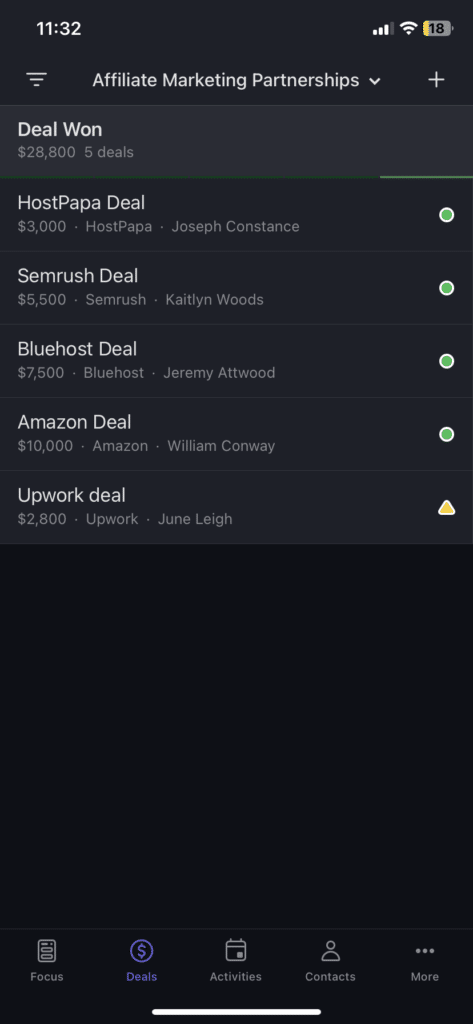
HubSpot Vs. Pipedrive Mobile App Winner: HubSpot
AJ’s Take: With its robust features and user-friendly interface, HubSpot’s mobile app takes the win in this category. Pipedrive offers a great mobile experience as well, but it falls short when compared to HubSpot.
HubSpot Vs. Pipedrive: Knowledge Center
When it comes to learning how to use a platform, having access to a comprehensive knowledge center can make all the difference.
Let’s see how HubSpot and Pipedrive compare in this aspect.
HubSpot Knowledge Center
HubSpot offers a great knowledge center filled with resources for learning the platform and improving your marketing and sales skills.
HubSpot also offers its powerful HubSpot Academy, a free resource for certified courses and training on inbound marketing, sales, and customer service.
The HubSpot Academy is a gold mine for those looking to level up their skills and knowledge.
Pipedrive Knowledge Center
The Pipedrive knowledge center is impressive. We were able to find helpful articles, videos, and webinars on a variety of topics.
Pipedrive also offers Pipedrive Academy, which contains a multitude of helpful videos and courses to take advantage of.
Pipedrive Vs. HubSpot Knowledge Center Winner: Tie
AJ’s Take: Both platforms offer extensive knowledge centers with valuable resources for their users. While HubSpot has the added bonus of its Academy, Pipedrive’s knowledge center is still a top contender in this category.
Pipedrive Vs. HubSpot: Limitations
No platform is perfect, and that includes both HubSpot and Pipedrive.
Let’s look at a few limitations for each platform.
HubSpot Limitations
Some of HubSpot’s limitations include the following:
- Limited CMS Hub customization – While this is a fantastic feature from HubSpot that allows you to create and personalize content, we would have liked to see more customization options from the platform.
- Pricing is a bit high – While HubSpot offers a free CRM, its professional and enterprise plans can be expensive for small businesses on a budget (up to $ 5,000/month).
Pipedrive Limitations
Pipedrive, while an excellent CRM, also has some limitations.
These include the following:
- Limited customer interaction views – Pipedrive’s interface is focused on managing deals but lacks the ability to easily view customer interactions in one place.
- Extra features can be pricey – Pipedrive charges extra for its campaign creation, LeadBooster, and project management. These are pretty essential CRM features, so it can be frustrating to pay extra for them.
HubSpot Vs. Pipedrive Limitations Winner: Tie
AJ’s Take: Both platforms have their limitations, but it ultimately comes down to what features are most crucial for your business. This round is a tie!
HubSpot Vs. Pipedrive: Which is Best for Small Businesses?
There you have it—our Pipedrive/HubSpot CRM matchup.
HubSpot is potentially the best all-in-one platform on the market, whereas Pipedrive offers some of the absolute best pipeline and project management in the biz.
However, if we have to pick just one winner here, it would be HubSpot. It’s got great customer service, an intuitive interface, a robust free plan, powerful automation, and all your CRM needs in one place.
So why not check it out today? After all, it’s 100% free with no strings attached!
Newsletter Signup
Join The Leads Field Guide Newsletter for tips, strategies and (free) resources for growing your leads, and closing more deals.

